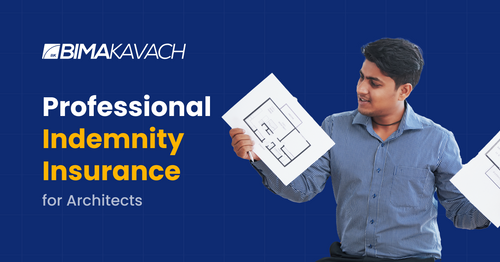Professional indemnity insurance is an essential aspect of any architect's business. Architects are often responsible for designing buildings that are safe, functional, and aesthetically pleasing. However, even the most experienced architects can make mistakes or face unexpected challenges during a project. Any errors or omissions in their work can lead to significant financial losses for their clients.
In these situations, professional indemnity insurance can provide peace of mind and financial security. It provides protection against claims made by clients who believe that the architect has not fulfilled his contractual obligations or has made a mistake in his work. Hence, this insurance is important for architects to carefully consider their insurance needs and make sure they have adequate coverage in place to protect their businesses.
Understanding Professional Indemnity Insurance
Professional Indemnity Insurance (PII) is a type of insurance that provides protection to professionals against claims made by clients for losses incurred due to the professional's negligence or errors. Any errors or omissions in their work can lead to significant financial losses for their clients, and PII protects professionals against such claims. The policy will typically cover the costs of legal representation, expert witnesses, and other expenses incurred in defending the claim. PII policies may also cover the costs of rectifying any errors or omissions made by the professional, which can be a significant expense.
Get Free Quote in Minutes

Why Architects Need Professional Indemnity Insurance
Architects require Professional Indemnity Insurance (PII) for several crucial reasons. Here are some key factors:
1.Financial Protection: Professional Indemnity Insurance provides architects with financial protection in case they are held liable for errors, omissions, or professional negligence in their work. This coverage helps mitigate the financial impact of legal claims and potential compensation payouts.
2. Legal Requirements: Many professional bodies and regulatory authorities in India make it mandatory for architects to have Professional Indemnity Insurance as part of their professional practice. Adhering to these legal requirements is essential for maintaining professional licensure and credibility.
3. Client Expectations: Clients often require architects to have Professional Indemnity Insurance before entering into contracts. This insurance serves as a reassurance to clients that they are protected in the event of any professional shortcomings, fostering trust and confidence in the architect's services.
4. Project Prerequisites: Certain projects, especially those involving public or large-scale developments, may necessitate architects to carry Professional Indemnity Insurance. It becomes a prerequisite imposed by clients or project stakeholders to ensure the smooth progression and successful completion of the project.
5. Risk Mitigation: Architecture involves inherent risks, and despite a professional's best efforts, mistakes can occur. Professional Indemnity Insurance acts as a safety net, allowing architects to focus on their creative and technical work while knowing they have a measure of protection against unforeseen professional liabilities.
6. Market Competitiveness: Having Professional Indemnity Insurance enhances an architect's competitiveness in the market. Many clients prefer to engage with professionals who demonstrate a commitment to responsible and risk-managed practices, and having PII is a tangible demonstration of this commitment.
7. Maintaining Professional Reputation: In the event of a claim or dispute, having Professional Indemnity Insurance helps architects handle situations with professionalism and responsibility. This can safeguard their reputation in the industry, demonstrating a commitment to accountability and ethical conduct.
To sum up, Professional Indemnity Insurance is a vital component of an architect's risk management strategy in India. It not only fulfills legal and contractual obligations but also contributes to the overall sustainability and success of their professional practice.
Types of Claims Covered in Professional Indemnity Insurance
Professional indemnity insurance for architects covers a wide range of claims, including:
- Design errors and omissions
- Failure to meet contract specifications
- Breach of professional duty
- Negligence or errors in project management
- Defamation or libel
- Breach of confidentiality
- Loss of documents or data
The policy also covers legal costs and expenses incurred in defending against such claims.
Exclusions in Professional Indemnity Insurance
Professional indemnity insurance for architects typically excludes certain types of claims, including:
- Claims arising from criminal or fraudulent acts
- Claims arising from intentional or wilful misconduct
- Claims arising from pollution or environmental damage
- Claims arising from bodily injury or property damage
- Claims arising from contractual disputes not related to professional services
It is important to carefully review the policy terms and conditions to understand the scope of coverage and any exclusions.
Choosing the Right Professional Indemnity Insurance
When it comes to professional indemnity insurance for architects, choosing the right policy is crucial. Here are some factors to consider and tips for comparing policies to ensure that you get the coverage you need.
A. Factors to Consider
When selecting professional indemnity insurance, architects should consider several factors, including:
- Coverage Limits: Architects should ensure that their policy provides adequate coverage for potential claims. This may depend on the size and complexity of the projects they work on.
- Exclusions: Architects should carefully review policy exclusions to understand what is not covered. Common exclusions include claims arising from pollution, asbestos, and cyber attacks.
- Retroactive Coverage: Some policies may offer retroactive coverage, which means that claims arising from work completed prior to the policy's start date may be covered.
- Insurer Reputation: Architects should research insurers to ensure that they have a good reputation for paying claims and providing quality service.
B. Tips for Comparing Policies
When comparing professional indemnity insurance policies, architects should consider the following:
- Premiums: Architects should compare premiums for similar coverage levels to ensure that they are getting a good value.
- Deductibles: Architects should consider the deductible amount and how it will impact their out-of-pocket costs in the event of a claim.
- Policy Terms: Architects should carefully review policy terms to ensure that they understand what is covered and what is not.
- Endorsements: Architects should review any endorsements or additional coverage options offered by the insurer to determine if they are necessary.
- Claims Handling: Architects should research how the insurer handles claims and how long it typically takes to process them.
By considering the factors above and comparing policies, architects can select the professional indemnity insurance policy that caters best to their needs.
Claims handling process in Professional Indemnity Insurance
Architects purchase professional indemnity insurance to protect themselves against claims of negligence, errors, or omissions that may arise during the course of their work. In the event of a claim, it is important to understand the process of filing a claim and the settlement process.
How to File a Claim
The first step in filing a claim is to notify the insurer as soon as possible. The policy may have specific requirements for notifying the insurer, such as a time limit or a specific contact person. The policyholder should gather all relevant documentation related to the claim, such as contracts, plans, and correspondence with the client.
The policyholder should then provide the insurer with a written claim, including a description of the claim, the amount of the claim, and any supporting documentation. The insurer may request additional information or documentation to support the claim.
Settlement Process
Once the insurer has received the claim, they will investigate the claim to determine if it is covered under the policy. If the claim is covered, the insurer will work with the policyholder to determine the appropriate settlement amount.
The settlement may involve payment to the claimant, or it may involve the insurer providing a defense for the policyholder in a legal action. The settlement amount may be negotiated between the insurer and the policyholder, or it may be determined by a court or arbitrator.
In some cases, the insurer may deny the claim if it is determined that it is not covered under the policy. The policyholder may have the right to appeal the denial or pursue legal action against the insurer.
To sum up, filing a claim and navigating the settlement process can be complex and time-consuming. Architects need to understand the requirements and procedures for filing a claim under their professional indemnity insurance policy.
Conclusion
Understanding the nuances of Professional Indemnity Insurance (PII) is essential for architects navigating the complex landscape of their profession. This specialized coverage not only safeguards against potential financial repercussions arising from errors or omissions but also reinforces the commitment to professional integrity and client trust. Architects must carefully assess their unique needs, stay informed about policy terms, and collaborate with reputable insurers to ensure comprehensive protection. With a well-informed approach to Professional Indemnity Insurance, architects can confidently pursue their creative endeavors, knowing they have a reliable safety net in place.
Frequently Asked Questions
- What are the consequences of not having professional indemnity insurance as an architect?
Not having professional indemnity insurance can leave architects vulnerable to financial and reputational damage in the event of a claim. Without insurance, architects may have to pay for legal fees and damages out of their own pocket, which could result in significant financial losses.
2. How does professional indemnity insurance protect architects from potential claims?
Professional indemnity insurance can protect architects from potential claims by covering legal fees, compensation, and damages that may be awarded against them. This type of insurance can also provide support and advice to architects in the event of a claim, helping to mitigate the impact on their business and reputation.
3. What factors should architects consider when selecting a professional indemnity insurance policy?
Architects should consider several factors when selecting a professional indemnity insurance policy, including the coverage limits, the scope of coverage, the cost of the policy, and the reputation of the insurer. Architects should also consider their specific needs and the types of projects they undertake when selecting a policy.
Read more about E&O Insurance

